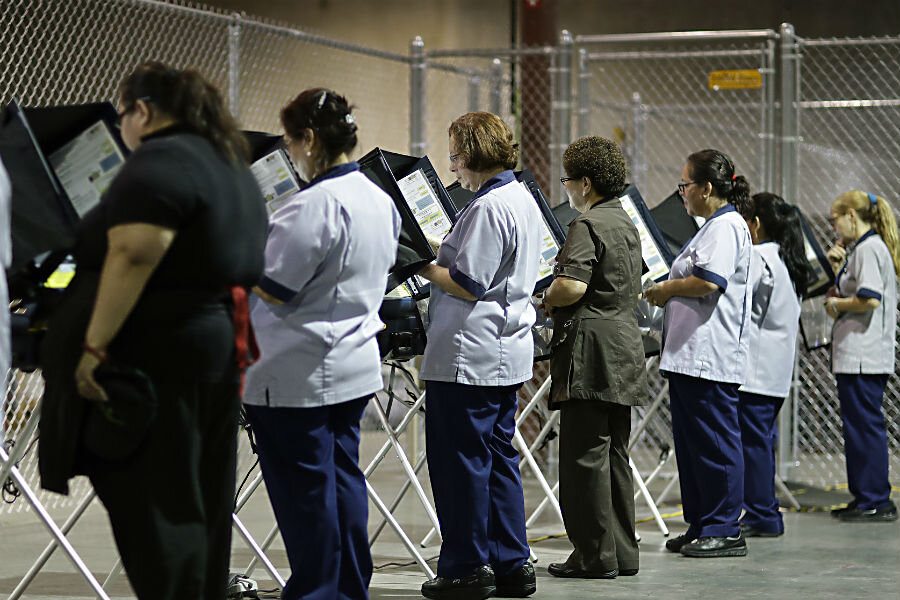Why we need a new Democratic party
Loading...
As a first step, I believe it necessary for the members and leadership of the Democratic National Committee to step down and be replaced by people who are determined to create a party that represents America – including all those who feel powerless and disenfranchised, and who have been left out of our politics and left behind in our economy.
The Democratic Party as it is now constituted has become a giant fundraising machine, too often reflecting the goals and values of the moneyed interests. This must change. The election of 2016 has repudiated it. We need a people’s party – a party capable of organizing and mobilizing Americans in opposition to Donald Trump’s Republican party, which is about to take over all three branches of the U.S. government. We need a New Democratic Party that will fight against intolerance and widening inequality.
What happened in America Tuesday should not be seen as a victory for hatefulness over decency. It is more accurately understood as a repudiation of the American power structure.
At the core of that structure are the political leaders of both parties, their political operatives, and fundraisers; the major media, centered in New York and Washington DC; the country’s biggest corporations, their top executives, and Washington lobbyists and trade associations; the biggest Wall Street banks, their top officers, traders, hedge-fund and private-equity managers, and their lackeys in Washington; and the wealthy individuals who invest directly in politics.
At the start of the 2016 election cycle, this power structure proclaimed Hillary Clinton and Jeb Bush shoo-ins for the nominations of the Democratic and Republican parties. After all, both of these individuals had deep bases of funders, well-established networks of political insiders, experienced political advisers and all the political name recognition any candidate could possibly want.
But a funny thing happened on the way to the White House. The presidency was won by Donald Trump, who made his fortune marketing office towers and casinos, and, more recently, starring in a popular reality-television program, and who has never held elective office or had anything to do with the Republican party. Hillary Clinton narrowly won the popular vote, but not enough of the states and their electors secure a victory.
Hillary Clinton’s defeat is all the more remarkable in that her campaign vastly outspent the Trump campaign on television and radio advertisements, and get-out-the-vote efforts. Moreover, her campaign had the support in the general election not of only the kingpins of the Democratic party but also many leading Republicans, including most of the politically active denizens of Wall Street and the top executives of America’s largest corporations, and even former Republican president George HW Bush. Her campaign team was run by seasoned professionals who knew the ropes. She had the visible and forceful backing of Barack Obama, whose popularity has soared in recent months, and his popular wife. And, of course, she had her husband.
Trump, by contrast, was shunned by the power structure. Mitt Romney, the Republican presidential candidate in 2012, actively worked against Trump’s nomination. Many senior Republicans refused to endorse him, or even give him their support. The Republican National Committee did not raise money for Trump to the extent it had for other Republican candidates for president.
What happened?
There had been hints of the political earthquake to come. Trump had won the Republican primaries, after all. More tellingly, Clinton had been challenged in the Democratic primaries by the unlikeliest of candidates – a 74-year-old Jewish senator from Vermont who described himself as a democratic socialist and who was not even a Democrat. Bernie Sanders went on to win 22 states and 47% of the vote in those primaries. Sanders’ major theme was that the country’s political and economic system was rigged in favor of big corporations, Wall Street and the very wealthy.
The power structure of America wrote off Sanders as an aberration, and, until recently, didn’t take Trump seriously. A respected political insider recently told me most Americans were largely content with the status quo. “The economy is in good shape,” he said. “Most Americans are better off than they’ve been in years.”
Recent economic indicators may be up, but those indicators don’t reflect the insecurity most Americans continue to feel, nor the seeming arbitrariness and unfairness they experience. Nor do the major indicators show the linkages many Americans see between wealth and power, stagnant or declining real wages, soaring CEO pay, and the undermining of democracy by big money.
Median family income is lower now than it was 16 years ago, adjusted for inflation. Workers without college degrees – the old working class – have fallen furthest. Most economic gains, meanwhile, have gone to the top. These gains have translated into political power to elicit bank bailouts, corporate subsidies, special tax loopholes, favorable trade deals and increasing market power without interference by anti-monopoly enforcement – all of which have further reduced wages and pulled up profits.
Wealth, power and crony capitalism fit together. Americans know a takeover has occurred, and they blame the establishment for it.
The Democratic party once represented the working class. But over the last three decades the party has been taken over by Washington-based fundraisers, bundlers, analysts, and pollsters who have focused instead on raising campaign money from corporate and Wall Street executives and getting votes from upper middle-class households in “swing” suburbs.
Democrats have occupied the White House for 16 of the last 24 years, and for four of those years had control of both houses of Congress. But in that time they failed to reverse the decline in working-class wages and economic security. Both Bill Clinton and Barack Obama ardently pushed for free trade agreements without providing millions of blue-collar workers who thereby lost their jobs means of getting new ones that paid at least as well.
They stood by as corporations hammered trade unions, the backbone of the white working class – failing to reform labor laws to impose meaningful penalties on companies that violate them, or help workers form unions with simple up-or-down votes. Partly as a result, union membership sank from 22% of all workers when Bill Clinton was elected president to less than 12% today, and the working class lost bargaining leverage to get a share of the economy’s gains.
Bill Clinton and Obama also allowed antitrust enforcement to ossify – with the result that large corporations have grown far larger, and major industries more concentrated. The unsurprising result of this combination – more trade, declining unionization and more industry concentration – has been to shift political and economic power to big corporations and the wealthy, and to shaft the working class. This created an opening for Donald Trump’s authoritarian demagoguery, and his presidency.
Now Americans have rebelled by supporting someone who wants to fortify America against foreigners as well as foreign-made goods. The power structure understandably fears that Trump’s isolationism will stymie economic growth. But most Americans couldn’t care less about growth because for years they have received few of its benefits, while suffering most of its burdens in the forms of lost jobs and lower wages.
The power structure is shocked by the outcome of the 2016 election because it has cut itself off from the lives of most Americans. Perhaps it also doesn’t wish to understand, because that would mean acknowledging its role in enabling the presidency of Donald Trump.
This story originally appeared on Robertreich.org.








